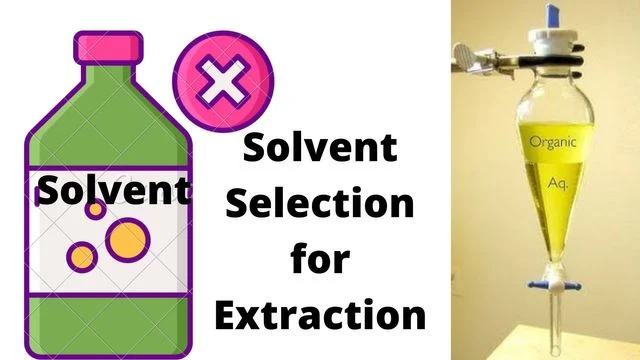Any particular liquid to be used as a solvent for extraction will not possess all the properties considered desirable for extraction and hence compromise is usually necessary for selecting the best solvent out of various possible liquid solvents available. While selecting a solvent for extraction, qualities such as selectivity, recoverability, distribution coefficient, density, etc. must be considered.
(1) Selectivity of solvent for Extraction
The ratio of the concentration ratio of solute to feed solvent in the extract phase to that in the raffinate phase is called the selectivity or separation factor. It is a measure of the effectiveness of the solvent in separating the Constituents of a solution. The selectivity should be greater than one for all useful extraction operations and if it is equal to one separation by extraction is not possible.
{tocify} $title={Table of Contents}
If B is the solvent feed containing A and C, where C is the solute and E and R are the equilibrium phase then selectivity β is given as
β = [wt. fraction of C/wt. fraction of A]E / [wt. fraction of C/wt. fraction of A]R
The selectivity (β) is analogous to the relative volatility (α) in distillation.
(2) Recoverability
As the solvent should be recovered for reuse frequency by distillation it should not form an azeotrope with the extracted solute and for low-cost recovery, the relative volatility should be high. The latent heat of vaporization of a solvent should be small whenever the solvent is to be volatilized.
(3) Distribution coefficient
Higher values (>1) of the distribution coefficient are generally desirable as less solvent will then be required for a given extraction duty.
(4) Density
The difference in densities of the saturated liquid phases should be larger for physical separation.
(5) Insolubility of solvent
The solvent insoluble in the original liquid solvent should be preferred. It should have a high solubility for the solute to be extracted as then small amounts of the solvent are required.
(6) Interfacial tension
Interfacial tension should be high for the coalescence of emulsions to occur more readily as the same is of greater importance than dispersion.
(7) The solvent should be stable chemically. It should be inert to the components of the system.
(8) It should not be corrosive to common materials of construction.
(9) The solvent should be cheap.
(10) The solvent should be non-toxic and non-flammable.
Distribution coefficient and Distribution constant
In dilute solutions at equilibrium, the ratio of the concentrations of a solute in the two phases is called the distribution coefficient or distribution constant K. Thus,
K = Ce/Cr
Where Ce and Cr are the concentrations of the solute in the extract and the raffinate phases respectively.
The distribution coefficient can also be given in terms of the weight fraction of the solute in the two phases in contact at equilibrium.
K' = Xe/Xr
Where Xe is the weight fraction of the solute in the extract and Xr is the weight fraction of the solute in the raffinate.
Ternary System of Liquid Extraction
The addition of a new solvent to a binary liquid mixture (of a solute in a solvent) yields different types of mixture.
1. The solvent may be completely immiscible with the feed solvent. This is the ideal case.
2. The solvent may be partially miscible with the feed solvent, forming one pair of partially miscible liquids. If A is the feed solvent, C is the solute and B is the extracting solvent, then C dissolves in A and B completely while A and B dissolve only to a limited extent in each other. This is the most common type of system.
3. A homogeneous solution may be formed, then the solvent selected is not suitable and should be rejected.
4. The solvent may lead to the formation of two or three partially miscible liquids. A and C are completely soluble, while A and B and B and C dissolves only to a limited extent in each other (two pairs partially miscible). It is observed occasionally and not desired.
Liquid-liquid extraction equipment and Classifications
Take these Notes is, Orginal Sources: Unit Operations-II, KA Gavhane

